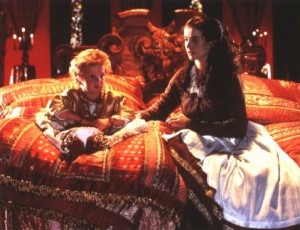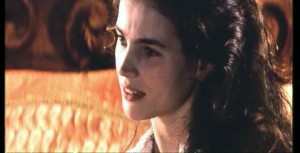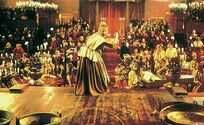The Baby of Macon
 Peter Greenaway’s films are more divisive than virtually every other filmmaker working today. He has stated publicly that he is no longer interested in traditional ways of filmmaking, developing characters, telling a straightforward story, etc. Even the best experience I had with a Greenaway film, the sumptuous The Pillow Book, I left a screening with twenty minutes to go. It’s not that the movie was unwatchable, it was that I had simply had had enough. Greenaway had given us a gorgeous collage of a film, with layer upon layer of images, and the effect had simply worn me out. With Greenaway, it’s not necessarily a question of tolerance, but endurance. The Baby of Macon, made in 1993, is the perfect example of this, as it was apparently so excessive that no distributor would touch it, and has received no video or DVD release in the US at all.
Peter Greenaway’s films are more divisive than virtually every other filmmaker working today. He has stated publicly that he is no longer interested in traditional ways of filmmaking, developing characters, telling a straightforward story, etc. Even the best experience I had with a Greenaway film, the sumptuous The Pillow Book, I left a screening with twenty minutes to go. It’s not that the movie was unwatchable, it was that I had simply had had enough. Greenaway had given us a gorgeous collage of a film, with layer upon layer of images, and the effect had simply worn me out. With Greenaway, it’s not necessarily a question of tolerance, but endurance. The Baby of Macon, made in 1993, is the perfect example of this, as it was apparently so excessive that no distributor would touch it, and has received no video or DVD release in the US at all.
Proving he would stick to his guns, The Baby of Macon, is less a movie, than a filmed play, with the camera aware of the audience watching the play, sometimes even having them take crucial parts within the plot of the performance. The audience within the film, dressed in aristocratic garb, fitting the period with which it takes place, the 1650’s. The play they are watching is an indictment of their behavior, exposing the hypocrisy of religion at its deepest core. Making obvious analogies to Jesus at every turn, the plot has a hideous (and never seen) older woman give birth to a child in a town where no woman has been able to produce any offspring for a long time. The belief, even by those who delivered the baby, is that there is no way for this woman to have given birth, and so when the woman’s daughter decides she will claim that the baby is her own, via a virgin birth, the town is more than willing to accept this notion. The daughter, played by Julia Ormond, manipulates the town into treating the child as a messiah, giving him gifts in return for being blessed, and possibly being allowed to have their own children.
 The film has more than a little in common with Ken Russell’s Salome’s Last Dance, also a filmed play where the audience was acknowledged and part of the action, though it was only author Oscar Wilde and his lover there. The biggest reason that The Baby of Macon remains unseen in the US is because of Greenaway’s tendency to be excessive, with garish and grisly bloodshed mixed with graphic and unerotic sex. He shares Russell’s fascination with constant excess and crudeness, though Greenaway’s attempts to shock seem a lot less childish. For the first hour of The Baby of Macon, you may wonder, what it is exactly the objection was to the material. If anything, the fear was that no audience would have patience for the film itself.
The film has more than a little in common with Ken Russell’s Salome’s Last Dance, also a filmed play where the audience was acknowledged and part of the action, though it was only author Oscar Wilde and his lover there. The biggest reason that The Baby of Macon remains unseen in the US is because of Greenaway’s tendency to be excessive, with garish and grisly bloodshed mixed with graphic and unerotic sex. He shares Russell’s fascination with constant excess and crudeness, though Greenaway’s attempts to shock seem a lot less childish. For the first hour of The Baby of Macon, you may wonder, what it is exactly the objection was to the material. If anything, the fear was that no audience would have patience for the film itself.
Comprised almost entirely with dialogue in the form of rhetorical questions, it is a completely distancing film. Every scene has a huge crowd in it, and I saw not one close-up in the entire 122 minutes. Greenaway never allows you to empathize with the characters, he wants the effect of watching a play, where the audience doesn’t have the camera, through placement, telegraph how they should feel. As the movie goes on, he reveals more and more artifices within what we have accepted as this film, eventually indicting even the viewer as a willing spectator in the on screen atrocities.
 The first section of the film has nothing particularly offensive in it, a smattering of nudity, the occasional bit of crude dialogue about the child’s anatomy, a Russell like bit of completely gratuitous flesh, where a woman sits down at a table and lifts her garments all the way up, “inadvertently” flashing the camera. But once the church enters the story, as they grow jealous that this child (whose dialogue is spoken by a narrator, a bearded man in his 60s, the child’s lips do not move) is taking attention away from them, and stealing the faith, the unpleasantness begins, surely a deliberate choice by Greenaway. Once a cow is slaughtered and a man is gored in the stomach by said cow, you’ll know that the point is being developed. The church is shown as the real corrupter, selling the child’s bodily fluids for profit to easily duped and wealthy members of the town.
The first section of the film has nothing particularly offensive in it, a smattering of nudity, the occasional bit of crude dialogue about the child’s anatomy, a Russell like bit of completely gratuitous flesh, where a woman sits down at a table and lifts her garments all the way up, “inadvertently” flashing the camera. But once the church enters the story, as they grow jealous that this child (whose dialogue is spoken by a narrator, a bearded man in his 60s, the child’s lips do not move) is taking attention away from them, and stealing the faith, the unpleasantness begins, surely a deliberate choice by Greenaway. Once a cow is slaughtered and a man is gored in the stomach by said cow, you’ll know that the point is being developed. The church is shown as the real corrupter, selling the child’s bodily fluids for profit to easily duped and wealthy members of the town.
How one reacts to all of this is completely dependent on the viewer. For the first half of the film, I was never really engaged, alienated by the stagy and self-conscious presentation. The religious commentary was too on the nose (Ralph Fiennes plays a character, one of the few with a given name, called Joseph, who is the son of the bishop, and whom Ormond tries to marry, so he can be the father of the child), the dialogue arch. But, oddly enough, as the criticism became more overt, I was drawn in, not by the debauchery (one character is ordered to be raped 300 times consecutively), but by the unsubtle parallels Greenaway kept drawing to current society as well as when he breaks down our perceived notions of the fourth wall. For example, there is the constant acknowledgment that these are actors on stage, performing a play. But then Greenaway changes your perspective when, during the rape, a character says to the woman being raped, “Imagine that, an audience of three hundred, and none of them know you’re not acting.” As he takes more and more chances like this, the film becomes completely engrossing.
 The only DVD available, as of 2009, is a woeful Australian disc (the disc is listed as R4 PAL, but it plays as R0 PAL). It is one of the worst transfers I have come across. I put the disc in my Malata 520, and the image was both stretched and cropped. The actors looked tall and skinny and the credits were lopped off at the side. The aspect ratio looked to be about 1.95, though the IMDB lists it at 2.35. I tried it in my computer, and it was identical, so I was sure that it was not my player that was mangling it. Luckily I was able to use my xy scaler to adjust it to make it watchable. The ratio I went with was approximately 2.40. The colors bleed everywhere, the MPEG artifacts are huge, whenever there is a darker shot or underlit, it’s almost impossible to make out at all. Obviously, the disc is non-anamorphic. You’ve been warned.
The only DVD available, as of 2009, is a woeful Australian disc (the disc is listed as R4 PAL, but it plays as R0 PAL). It is one of the worst transfers I have come across. I put the disc in my Malata 520, and the image was both stretched and cropped. The actors looked tall and skinny and the credits were lopped off at the side. The aspect ratio looked to be about 1.95, though the IMDB lists it at 2.35. I tried it in my computer, and it was identical, so I was sure that it was not my player that was mangling it. Luckily I was able to use my xy scaler to adjust it to make it watchable. The ratio I went with was approximately 2.40. The colors bleed everywhere, the MPEG artifacts are huge, whenever there is a darker shot or underlit, it’s almost impossible to make out at all. Obviously, the disc is non-anamorphic. You’ve been warned.




Tom Nichols says:
March 19th, 2014
6:04 pm
Nice article.
Did you notice the colour red in every shot? The colour of anger and chaos. If anything made me hate this film it was that.
And that’s the weird thing, it’s immaculately made, but I hate the film. The only likeable character is Fiennes and… well… he didn’t last long.
btw, she gets raped 207 times not 300. You may think I’m being picky, but that’s 93 rapes.
Lou Gubrious says:
November 17th, 2019
8:01 am
One could, if one wanted to, draw a line from the unprecedented and historic international controversy of Scorsese’s “The Last Temptation Of Christ” in 1988, directly to the banning and suppression of this extraordinary film just 5 years later in 1993, with it’s searing and brutal Brechtian-style attack on the entire mythos of Christian theology. And one could even speculate that Greenaway was possibly influenced by the immense impact that “Last Temptation” had around the world in terms of it’s epic assault on the iconography of Jesus, and spurred on to put his own unique and innovative signature on the same subject matter.